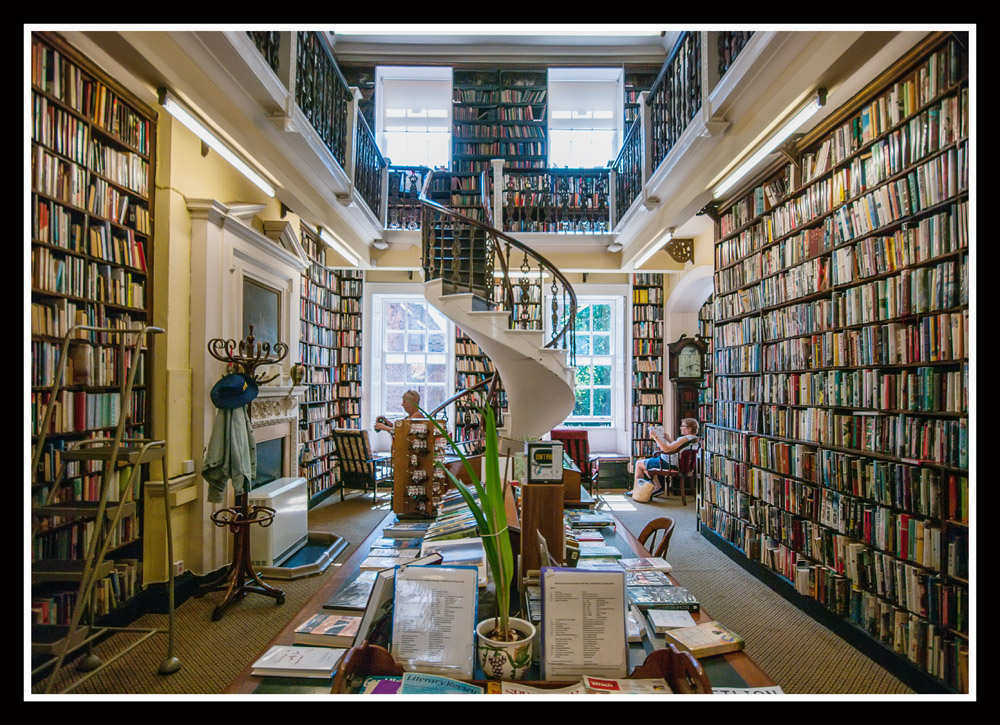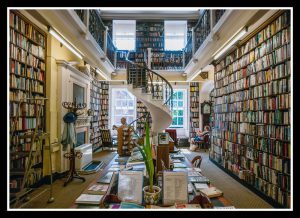
December 10, 2019, by Digital Research
Immersive technologies and the heritage sector – Bromley House, Nottingham
Immersive technologies, such as Virtual Reality (VR) and Augmented Reality (AR), allow heritage venues to create exciting digital experiences.
Dr Jo Robinson is a Professor in Drama and Performance at the University of Nottingham. She is interested in exploring relationships between place, space, and community. As part of an AHRC award, Jo is helping organisations around Nottingham to share their histories. She has previously worked with Ben Bedwell from the Digital Research Team to develop a digital archive for Nottingham’s Theatre Royal. Jo has now partnered with Bromley House Library, an independent lending library housed in a Grade II* listed building in Nottingham’s city centre.

Inside Bromley House; by Andy in accordance with CC BY-NC-ND 2.0 license.
With Ben’s support, Jo and the staff from Bromley House were keen to explore digital recording technologies for capturing the state of the Library before major structural renovations. They also wanted to turn those snapshots into a digital experience to entice and inform visitors.
Capturing Bromley House
Initially, the team ran a workshop involving researchers from UoN, and members of staff and volunteers from Bromley House. At this workshop, participants tested a range of low-cost techniques for digitally capturing environments, including 360° photography, photogrammetry, and laser-based depth scanning. Previous entries in the Digital Research blog explain how we have used some of these techniques to capture real-world environments and turn them into VR experiences.

University of Nottingham academics and Bromley House volunteers
Informed by the workshop, Bromley House staff and volunteers embarked on a period of self-directed experimentation, capturing 360° images of the Library’s attics – including the Midlands’ earliest photographic studio – and 360° video walk-throughs, all before the builders moved in for the renovations. The Ricoh Theta 360° camera became a firm favourite with the staff and volunteers, who said:
“It’s really easy, like using a mobile phone camera, and encourages you to be creative with the way you photograph the rooms; even more so once you get your head around the potential for 360° video”
Unlike traditional cameras that force users to focus on one feature, 360° images allow both photographers and viewers to look around and choose what interests them most. This translates into more time spent exploring a space. A member of the Bromley House team explained:
“I spent a lot of time filming from different positions, even trying to run the camera around on the floor: the video from this really felt like a mouse-eye view of the library. We wouldn’t use that footage, but just trying it sparked more ideas about how to creatively introduce the Library. What would a mouse have to say about what they’d seen and heard going on here?”

Panorama of Bromley House
Experiencing Bromley House
Using a WordPress plugin, the staff and volunteers went on to embed some of the 360° images as interactive elements of the Library’s WordPress website – a feature that became the most-visited page on the site. They also turned the images into VR experiences for Google Cardboard, thus creating an immersive experience of the heritage building. They were keen to emphasise that:
“Google Cardboard just uses my phone, and the 360° camera also transfers images to my phone, so it was really quick to get that simple VR experience going. If I had hit any real barriers then I would’ve stopped”
It also turned out that one of the team members had expertise in photography:
“Our volunteer is basically a professional photographer, and it was obvious how much difference he made by knowing how to light the rooms. The 360° camera wasn’t great in the dark, and this is a historic building where lighting can be tricky”
Diminishing returns
Going a step further, Ben decided to combine the 360° images with audio to create higher fidelity VR experiences for Unity-capable VR devices, such as Oculus Go. Ben’s prototyping demonstrated some of the challenges of working in Unity. In addition to learning the basics of 3D modelling in Unity and deploying to VR devices, 3D rendering requires a relatively sophisticated computer. The higher resolution display in the Digital Research Team’s Oculus Go also magnified some of the quality issues in the 360° images, issues that were not visible when the images are viewed on the Bromley House website or through Google Cardboard. Ben summarised the team’s feelings:
“One thing this project has shown is how inaccessible the newest immersive technology is to organisations without dedicated digital developers. On the other hand, we’ve been genuinely surprised by how creative the staff and volunteers have been with the tech that – while no longer cutting-edge – is cheap, accessible and underappreciated”.
Jo and Ben are continuing to work with Bromley House to understand how these types of accessible immersive technologies can enable new forms of community participation in cultural organisations. Bromley House is confident that digital transformation is vital to sustaining their position as an important cultural venue in Nottingham, both by widening membership, but also by providing opportunities for all volunteers to experiment and gain confidence with digital technologies.
Sorry, comments are closed!
